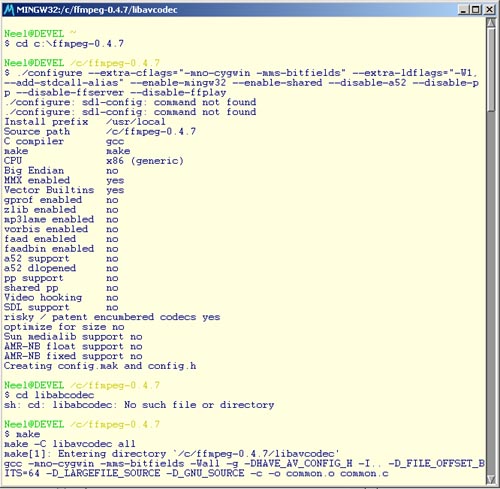整个安装是首先安装MinGW,然后安装MSys。
其中,需要coreutils-5.97-MSYS-1.0.11-snapshot.tar.bz2,
Unpack the file. Copy coreutils-5.97\bin\pr.exe to C:\msys\bin\.
然后
./configure --enable-memalign-hack最后make和make install.
If you followed Building FFmpeg SVN statically correctly, you should already have static libraries built.
After you make install, they will be installed in
Yes, those libraries can be used by MSVC++. Think of them being the same thing as the .lib files MSVC++ generates.
参考网站:http://ffmpeg.arrozcru.org/wiki/index.php?title=MSys_MinGW
到此为止。
以下为开始收集到的一些资料:
Installing FFMPEG from the source in window platform is easy as you do for other window application. Here is the complete instructios how to build FFMPEG in windows. To install FFMPEG on windows you need to install third party MinGW and MSys library that is compatible with GCC. This library is required to build ffmpeg in windows and support shell to run commands.
Download MinGW and MSys
MinGW: MinGW Direct download link
MSys: MSys Direct download link
SF Link: Sourceforge MinGW MSys Package Download Page
FFMPEG: FFMPEG Download fully patched version
Building FFMPEG
It is time to install ffmpeg. Extract downloaded ffmpeg archive in c: folder. If you have not downloaded yet please download now then run MSys.bat file from C:\msys\1.0\ folder. This location will be depend on you MinGW and MSys installation. In the command prompt run the following commands:
$ cd c:/ffmpeg-0.4.7
$ ./configure –extra-cflags=”-mno-cygwin -mms-bitfields” –extra-ldflags=”-Wl,–add-stdcall-alias” –enable-mingw32 –enable-shared –disable-a52 –disable-pp –disable-ffserver –disable-ffplay
$ make
This tutorial is about transcoding video fom one codec into another using FFMPEG. I got deeper into FFMPEG when I wanted to transcode into FLV (Flash Video) and it works very well. I developed the Riva FLV Encoder, a GUI for FFMPEG.
Update 26.10.2006: This tutorial is a little outdated as there were many changes in FFMPEG like the switch from CVS to Subversion and the workflow to compile FFMPEG under Windows has become more difficult. For the new tweaks check this tutorial.
- Download MinGW ” MSYS current releases (Window Exe Binaries MSYS-1.0.10.exe & MinGW-3.1.0-1.exe)
- Install MinGW
- Install MSYS
- HINT: During the Postinstall be sure to set the right path to MinGW with a “/” instead of a Windows-”". If you did it wrong anyway re-install MSYS to the same directory and do the postinstall right (I missed it a few times)
- Download and compile Lame
- Extract Lame to your MSYS home-directory
- Open MSYS and change to your lame-directory (cd ../lame-XXX)
- Enter the following commands:
./configure //(takes a few minutes) make //(lame is being comiled; takes a few minutes, too) make install
- After installing you will recognize that there are new directories and files in MSYS/local which we will use while compiling ffmpeg with mp3-support
- Download Subversion Client like Tortoise SVN (http://http://tortoisesvn.tigris.org/) and install it
- Check out the sourcecode from svn://svn.mplayerhq.hu/ffmpeg
- Compile FFMPEG
- Change the directory in MSYS to your ffmpeg-directory (cd ../ffmpeg)
- Enter the command:
./configure --enable-memalign-hack --enable-mingw32 --enable-mp3lame --extra-cflags=-I/local/include --extra-ldflags=-L/local/lib
- HINT: you can paste into MSYS by pressing your center mouse-button
- “–enabled-memalign-hack” is a Windows hack. Without this option ffmpeg always crashs with the message “removing common factors from framerate” when encoding AVIs.
- “–enable-mingw32″. I see no difference without it but we compile with MinGW and it would not do a harm when ffmpeg knows this
- “–enable-mp3lame”: Enable transcoding audio with the open-source mp3-lame-codec
- “–extra-cflags=-I/local/include –extra-ldflags=-L/local/lib”: The cflags- and ldflags-parameter sets the right path to your lame-installation which you did in step 3.d.
- Enter command: make (ffmpeg is being compiled; takes a few minutes)
- With “make install” you could now copy the ffmpeg.exe to c:Program Filesffmpeg. But there is no need to.
- Use FFMPEG
- Copy your compiled ffmpeg.exe from your MSYS directory to the directory where you like to transcode with ffmpeg
- Open the Dos-Shell and change to the directory where you copied the ffmpeg.exe
- Copy a test.mpg into your directory and enter the following command:
ffmpeg -i test.mpg -ab 56 -ar 22050 -b 500 -r 15 -s 320x240 test.flv
- Your first FLV should be encoded now
- Render Images from a Video
- Enter command:
ffmpeg -an -y -t 0:0:0.001 -i test.flv -f image2 test%d.jpg
- HINT: With -t you set the length of images to be extracted. Above we entered 1 millisecond the extract one image. If you miss this parameter all images of the video will be extracted
Compiling FFMpeg
FFmpeg is developed under Linux, but it can be compiled under most operating systems.
For Windows, FFMpeg can be compilied by MSYS and MingGW. If you had setup MSYS and MingGW system correctly, you can compile FFMpeg under it's folder.
1. Cleanup former build results.
make distclean
2. Setup build parameters.
./configure --enable-shared --disable-static --enable-memalign-hack If there are no errors, and config.mak and config.h generated, you can build the library, and then, if you want, you can install them into MSYS environment.
make
make install
Using FFMpeg in Your Visual C++ Environment
1. Create inttypes.h and stdint.h if you don't have them. Attachment is a copy of these two files. You can get them from other place if you want.
2. Setting up Additional Include Directories and Additional Library Directories. By default, these folder is under your MSYS folder, for example:
/usr/local/include
/usr/local/lib
3. Add FFmpeg's shared libraries, include libavutil.lib libavcodec.lib libavformat.lib:
4. Include the FFMpeg header,
#include <ffmpeg/avformat.h>
#include <ffmpeg/avcodec.h>
Using the FFMpeg code
There are an example within FFMpeg, output_example.c. But if you copied codes from this example, following tips may ensure you compiles successfully.
1. Add required casts.
2. Change snprintf to _snprintf

没有评论:
发表评论